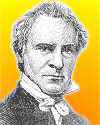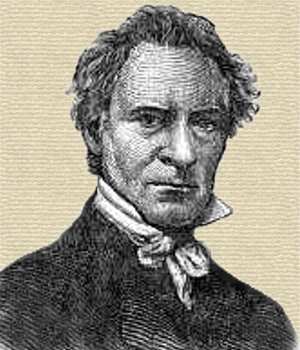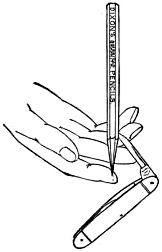 (source)
(source)
|
Joseph Dixon
(18 Jan 1799 - 15 Jun 1869)
American inventor and manufacturer who pioneered industrial uses for graphite, including manufacturing the first pencils made in America.
|

Article from Good Housekeeping (July 1894)
If it is true - and who doubts the correctness of the saying - that “the pen is mightier than the sword” the claim may be justly made that the pencil not only outnumbers both of these, but is more useful and more used than the pen, and at once prettier, more peaceful and less disastrous and destructive than the sword.
Before pencils were invented and used, goose quills did the work that both of them are now appointed to do. There were lead pencils then; something unknown at the present day, although the general speech of the people is now as then of a lead pencil. But lead or no lead the crude plummet and pencil of only two or three generations ago, has been evoluted into the handy, useful and attractive looking pencil of to-day; has gone the way of all the earth, with the wafer-box, in which were stored the thin, round, red wafers with which we sealed our letters; the more aristocratic stick of sealing wax; and the sand-box that held the sand, then doing the service which the blotter pad does now.

But it is the pencil of to-day that this paper is dealing with. In order to treat the subject intelligently, we take for our object-lesson text a representative establishment in this line of commercial traffic - The Joseph Dixon Crucible Company, with works and general offices in Jersey City. N, J. and Graphite mines and mills at Ticonderoga, N. Y. We select this concern, as it is the oldest, largest and most comprehensive representative of the industry of pencil making and dealing in the world. Joseph Dixon, the founder of The Joseph Dixon Crucible Company, was a native-born Yankee, having first seen daylight at Marblehead, Mass. in the last year of the eighteenth century. His greatest invention was that of the plumbago or black graphite crucible, for reducing the finer metals, and he had also a wide and valuable reputation as a manufacturer of Dixon's “carburet of iron” stove polish. It is with a pencil that these lines are written, but not a lead pencil, unless graphite may be called “lead” from its long use in the manufacture of what are known as “lead” pencils. So are thousands of other other sermons, addresses, editorials, reports, business documents, political harangues, commercial memoranda, etc., and it is The Joseph Dixon Crucible Company's graphite pencils that are doing the larger part of this world-wide work-day service, easily, serviceably and satisfactorily. The graphite is mined at Ticonderoga. N.Y. Here the Dixon Company has an immense water power, where Lake George pours its waters into Lake Champlain, with a ninety-foot square six-story building for the preparation of the graphite after mining. The process of preparing the graphite is thus described in a booklet recently issued under the title of “The History of the Lead Pencil:”
“The graphite is first reduced to an impalpable powder by grinding. Water is then added, and the substance is run through mixers in a fluid state, in order to combine with it whatever quantity of clay may be necessary to give it the grade desired. The more clay, the harder the lead, and vice-versa. After this mixing has been done, which is performed entirely by machinery, the mass is taken from the mixers and run through filter-presses in a war to exclude the water and reduce it to a doughy consistency. In order to make the mixing still more thorough, the doughy mass is then passed through dies, by which is meant plates with numerous small perforations, under great pressure, from which the lead - as it is called in deference to common phraseology - issues in tiny rods or wires, in general appearance not unlike the 1ead that is put into the pencil, but instead of being dry and brittle, being still in a moist or soft condition. The material receives this treatment repeatedly through dies with apertures of different diameters, until finally, when the mixing has been satisfactorily completed, and the mass is in proper condition, it is passed through a set of dies of the exact diameter of the lead that is to go into the pencil. Deft fingers take the product in this condition, straighten out the leads, and cut them to lengths of about three feet. At this stage it is still comparatively soft and pliable. After being cut, the leads are allowed to dry, and are then cut to the required pencil lengths and packed in crucibles and burned for several hours, in order to extract the last degree of moisture that remains., and to bring the lead to its final condition. The lead is now ready for inserting in the wooden case.”

The companion product for these graphite pencils, as fashioned and formed for business purposes, is cedar wood, from which the wooden cases are largely made. The source of this supply is Florida, and the extinction of the supply of black walnut woods is being repeated in the rapid wasting away of the once supposed to be inexhaustib1e supply of cedar wood. So pronounced as this condition of affairs fast-becoming, that some other source of supply will be found necessary at an early day. The same authority above mentioned, gives the following particulars regarding the handling of the cedar wood in preparation for pencil cases, with a product of 30,000,000 pencils a year by The Joseph Dixon Company alone.
“The cedar is shipped from Florida in small blocks or slabs, a little longer than a pencil in length, a little wider than four or six pencils in width, and of proper thickness. Notwithstanding it is carefully assorted where milled out, the first treatment that it receives when it reaches the Dixon pencil factory is careful selection as to grade; and then follows the dyeing process, in case the wood is to be colored, for certain grades of pencils, and the treatment which takes out the essential oil, and last, but not least, the processes which season it perfectly.”
But as in the case of the destruction of the whale, and of the complete abandonment of the whaling fields, when Pennsylvania first poured its oceans of oil out of the earth, so will some other material be found for the pencil wood, when the present source of supply has become exhausted.

“Where liberty dwells, there is my country,” and it may as surely, if not patriotically, be said, where paper dwells, there is the pencil. The connection between these sayings is in “the application on't.” and in recognition of the solemn fact that liberty would not be worth much without paper, and the country, nowadays, of much account without the pencil. The evolution of the old-time lead plummet, and the omnipresent pencil of to-day may well furnish foundation material for a brief but interesting, story illustrated with sketches of a schoolboy, and a school-girl at well, with “plummet” and “ruler,” drawing the lines for a forthcoming writing lesson, on a sheet of foolscap paper; when the scratchy tracing of a “gray goose quill” was all the sound we heard, “save now and then the often dolefully and long-drawn exclamation of 'Master, please to mend my pen.'" Looking at the then and now of these things, as it appears to us at present.. we have a dissolving view of dropping easily from the ridiculous to the sublime, instead of “from the sublime to the ridiculous,” a more often quoted saying. The flat plummet, in turn, was fashioned into a somewhat crude, oval-shaped pencil, then into a round one, the slate pencil doubtless furnishing the pattern or form to work from.
In brief, the plummet has gone, and is almost forgotten. The crude lead pencil has been fashioned into comely, graceful shapes of graphite, at once useful and ornamental, easy to handle, convenient to carry, often poised on the ear, where it shou1d never be found; serviceable to the household, counting room, restaurant, schoolroom, and domestic and social as well as business life; the studio of the artist, the workshop of the mechanic, and indoors and out, everywhere. With the pencil we make memoranda of what we are to do, and records of what we have done; with it we write our orders for the marketmen, and keep the run of things in the home life; note down headings for sermons, speeches, addresses and “talks;” put on paper suggestions, reminders, conclusions and data of the times, of when and where we came into the world, what we do while in the world, and make mention of what we are intending to leave behind when we go out of the world. So on, and on. These are some of the things we do with pencils, and after a recital of this bit of history, the inquiry comes without effort, “"What should we do without the pencil?” If any wiseacre is wise enough to inform us, will he or she please rise and “"communicate.”
Oft and often valuable improvements are the result of no special effort or circumstance - are not “born,” but, like Topsey, they “growed,” and came to maturity by means of the elements they fed upon. The pencil, once a luxury, is now a necessity, and to-day is in every man's hand, and every woman's pocket - whenever her pocket can be found - and on every school teacher's and every child's school desk. Without it, commercial life would be brought to a standstill; domestic doings would be paralyzed, and social, political and religious circles and arenas would be but barren fields of human activity.
The most gratifying feature of this pencil industry is the fact that the American make is found vastly superior to the foreign or imported article. The Dixon pencils were first introduced into our schools in 1872 and their superiority over those of other manufacturers has been remembered during all the years that these school-day little ones have been becoming “children of a larger growth,” until it is only truth to say, that not only everybody uses pencils, but that everybody uses the Dixon American graphite pencil.
There is such a variety of these that time and space would fail to enumerate them. In brief, there is the ordinary black pencil, the red pencil, the blue pencil, the green pencil, the yellow pencil, the terra- cotta pencil and the most dreaded of these among literary contributors to journalism is the little blue pencil, which the editor sometimes wields so unmercifully. There are soft, medium and hard pencils, draughtmen's pencils, architects' and artists' pencils, lumber pencils, black and colored crayons, prominently listed, to which many other names might be added; all of the best quality of material and finest make and finish.
The comprehensive finale of this story may best be told by a paraphrase of Leigh Hunt's “Abou Ben Adhem,” something like this:-
Awoke one night from a sweet dream of peace
And saw, within the moonlight in his room,
Making it rich, and like a lily in bloom,
An angel, writing in a book of gold.
Exceeding peace had made Ben Adhem bold,
And to the Presence in the room he said,
'What writest thou? And with what kind of pen?'
The Vision raised its head, and quickly then
Replied, 'With pencil, and the very best,
And the Dixon Graphite leads all the rest!'

There is probably no illustration quite so humorous and catching as the above, which has been for years a leading feature of the company's advertisements, and, we suppose, indicates the pleasure of the coming, men and women at having a pencil so satisfactory.
- 18 Jan - short biography, births, deaths and events on date of Dixon's birth.
- The Pencil: A History of Design and Circumstance, by Henry Petroski. - book suggestion.




